Tag team technology...
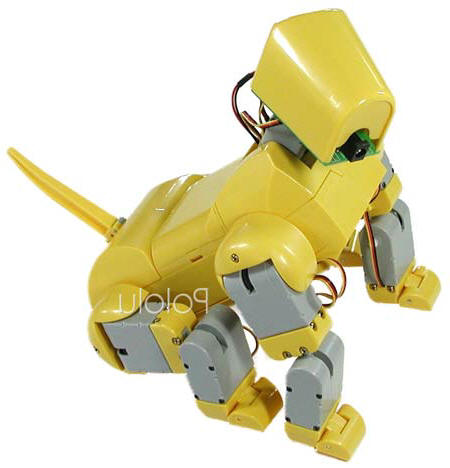 Tony
di Bartolo used to employed to research various products to help with inventory tracking and
job shop production control. That's when he first started thinking about using the new
technology for agility. Then one day while he was working, he came across an idea which made
him think, 'Hey, wouldn't it be great if you could use this in agility?'
Tony
di Bartolo used to employed to research various products to help with inventory tracking and
job shop production control. That's when he first started thinking about using the new
technology for agility. Then one day while he was working, he came across an idea which made
him think, 'Hey, wouldn't it be great if you could use this in agility?'
One of the things that caught his imagination was an item called an Radio Frequency
Identification or RFID. It is similar to the inventory security tags that are hidden in many
retail packages to help prevent theft from stores.
RFID tags are miniscule microchips, which already have shrunk
to half the size of a grain of sand. They listen for a radio query and respond by transmitting
their unique ID code. Most RFID tags have no batteries. They use
the power from the initial radio signal to transmit their response.
The premise behind these devices is that they trigger a security circuit when they pass
between the scanners at the exit door of the store. There are many more types of RFIDs than
just these simple devices. They are available both as an active or a passive device.

Now a little background.
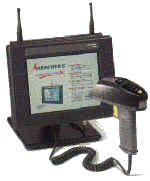 How
does RFID technology work?
How
does RFID technology work?
Radio frequency identification technology is an automatic way to collect product,
place, time or transaction data quickly and easily without human intervention or error. An RFID
system comprises a reader (or interrogator), an associated antenna and the transponders (tags/RFID
cards) that carry the data.
The reader transmits a low-power radio signal, through its antenna, that the tag receives
via it's own antenna to power an integrated circuit (chip). Using the energy it gets from the
signal when it enters the radio field, the tag will briefly converse with the reader for
verification and the exchange of data. Once the data is read, it can be sent to a controlling
computer for processing and management.
Whatís the typical read range for RFID devices?
The majority of RFID transponders have a read range of less than three feet. Some
applications limit the read range to around 6-8 inches. Some newer technologies (UHF systems)
do have a longer read range that can be 20-25 feet, but these systems are intended for pallets
and shipping crates. Read range depends on many factors, but the size of the transponderís
antenna, the size of the readerís antenna and its output power are the main ones. With
battery-less transponders, long read range and small size are mutually exclusive.
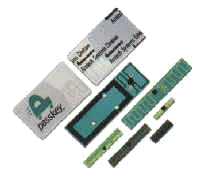 These
products are available as self-adhesive paper strips tags that can be hung on a key chain,
implantable biochips and wristbands. The readers are compliant with all current networking
protocols.
These
products are available as self-adhesive paper strips tags that can be hung on a key chain,
implantable biochips and wristbands. The readers are compliant with all current networking
protocols.
An idea is born
So this is where my creative thought processes began to take over and sat second
fiddle to my imagination. I thought 'Wouldn't it be great if you could use this in agility for
timing and tracking dogs?" I, of course, answered myself in the affirmative.
Why not place a self-adhesive strip unique to each dog on the fur on top of the head or onto
a flat collar. It would first identify the dog to the computer and then time the dog's run
using reader poles as the start and stop lines.
 21st
century technology
21st
century technology
Then I began to think of the other pieces of
technology that could be incorporated into an agility trial to help cut down on human error. My
ideas ranged from a pad that the scribe would use to enter the faults to pressure sensitive
mats on all the contact zones that, when activated by one pound of pressure, would operate a
time adjustable high intensity green led light to indicate whether or not the dog has made
contact.
Another one of my ideas is a virtual reality glove that the
judge would wear to signal faults to the computer direct, thus eliminating the scribe
altogether. The system would ID the dog and its jump height, start timing its run, gather the
information on faults, print out two copies of the scribe sheet and store electronically all of
the completed runs for sending on to the governing venue. At the same time, it would sort
qualifying runs and placements for the various height categories. Undoubtedly it would speed up
trials by not requiring run orders but only height changes, make the posting of results and
award of ribbons almost immediate and cut down the need for just about anyone other than ring
crew and judges.
Also there are light poles that have red, yellow, green or
blue lights that could be used to signal the competitor to start the run.
Paying the price
All of this technology costs money, but if there
were enough agility competitors willing to spend just a little more to insure speedy, error
free trials this just may be the future of agility in the 21st century.
|
About the author...
American Tony di Bartolo is a 52 year old male who stands 6'1" tall and
weighs 167 pounds. He has brown hair and brown eyes. He is blind in the left eye.
Tony started training in agility with the black tri Aussie Stella - she
adopted him - after he married his love Debbie. They have been training and
trialling for
about 3.5 years.
He met his wife on line - just before the Internet took off - on a local
BBS (bulletin board system) playing games and now helps her with her web site
AfterHours
Australian Shepherds by writing articles, poems and songs. He even helped start their
own Agility Aussie Club.
He is an 18 year member of the New York Air National Guard and has the
rank of Staff Sargeant. |
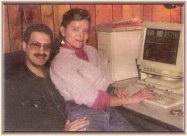
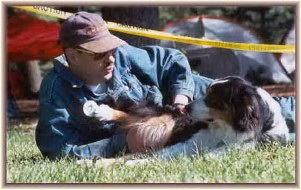 |